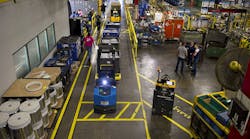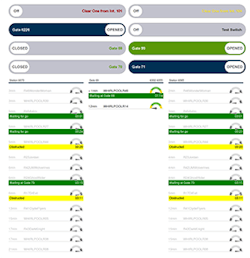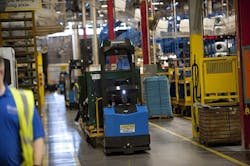Using humans only to haul 200-lb appliances across a 2.4 million sq-ft facility isn’t the best way to embrace lean manufacturing. It’s certainly not the reason Whirlpool reshored its commercial washing machine manufacturing from Mexico to Ohio in 2013. It’s a job better left to the motor-driven pack mule of the 21st century: the automated guided vehicle.
Whirpool’s washing machine plant in Clyde, Ohio, the largest in the world, has over 50 of Seegrid’s Vision Guided Vehicles, self-driving pallet trucks and tuggers that use five pairs of cameras for human-like stereoscopic vision. They also need to communicate like humans, so the company created Supervisor, a platform that allows humans to direct and monitor hundreds of VGVs at a time.
Seegrid's Vision Guided Vehicles use five camera pairs to see like humans, and
navigate the factory floor with ease.
Photo courtesy Seegrid
The latest version, out this month, includes Subway Platform, a way for the flesh-and-blood assemblers to keep track of the metal material handlers and ensure production is running smoothly and efficiently.
Jeff Christensen, Seegrid’s vice president of products and services, tells us how the company and client worked together to perfect the new feature, as well as how the VGVs and people work together to optimize the manufacturing process.
NED: How do Seegrid’s Vision Guided Vehicles work?
JC: A key value is that they don’t have to change anything about their site to get them to work. The cameras are in five precisely spaced pairs and take two pics simultaneously that look slightly different because of the distance. When you compare them, it creates a parallax effect to tell how far away something is. That’s how stereo vision in people works. That’s how you get depth perception.
Example of the Subway display.
Image courtesy Seegrid
We not only know something is there, but how far away it is. That creates a digital representation in space in their facility. We record that and go back and take all the same pictures again and find points in the three-dimensional space and make minor course corrections based on three-dimensional geometry and math. We do that a couple times a second as we’re driving along. This allows us to navigate in a full physical space without putting targets on walls or reflectors.
NED: Why was the Subway Platform feature added?
JC: Supervisor helps people understand what the shiny new autonomous vehicles are doing. You can have maps that show the whole picture and animated trucks moving around, but working with Whirlpool, we found out more about the contextual info that’s useful.
If I’m a manufacturer and I have VGV bringing parts to the assembly line, and I’m the person unloading parts, the thing that I want to know is: “Is the next one going to arrive on time? Do I have confidence or do I have a problem somewhere else I have to deal with?”
With a robot driving, you don’t have someone you can ask on the radio. We use the metaphor of standing on a subway platform, because when you’re on one, the only thing you really care about is when the next train comes to you. You don’t care about the express train that’s going to pass by. With it, they can configure to show a specific location in the factory and that gives them a context view of which vehicle is on the way to them and the estimated time of arrival. It takes a couple seconds and they don’t have to look at a large map or get on the radio.
NED: How did you develop it?
JC: We worked directly with Whirlpool to see the types of problems and environments to make the fleet more efficient. We looked at the data stream and ways of capturing the data. It was very collaborative, with a user-centered design methodology. We also ensured it was as flexible as possible, and that they were able to configure it themselves and have big dashboard of multiple platform views to look at 10 different stations on one giant screen or each individually. We tested it internally and had local customers test it to make sure we weren’t missing any environmental assumptions.
NED: How much extra will it cost?
JC: We’re adding it in. We try to offer people as many features as possible so they don’t have to pay a little extra for this one new feature. I’m not philosophically on board with that. I want them to have access to all of these things because it makes the product so much more valuable. Existing customers will be upgraded so they have access as well.
NED: How does it improve productivity?
JC: You want to be investing in value added and cutting cost, trying to obtain a high degree of predictability. The Lean Manufacturing movement is all about doing that: looking for value-added and reducing unpredictability. That’s what automated vehicles do. They never take breaks, don’t get sick, and work all three shifts. They’re the best movers you will ever hire and safer than human drivers. They never get in accidents, don’t injure people, and don’t go over the speed limit. This allows manufacturers to relocate people to something of higher value, like actually assembling washing machines. That’s where Whirlpool creates value that they will get revenue from.
VGV Pro: They never get sick.
VGV Con: You don't get cake when it's their birthday.
NED: Whirlpool just brought back 100 jobs to America. Are those jobs now at risk due to overachieving robots?
JC: Supervisor’s role is to give the people a better understanding of what the automated vehicle is doing both right now and over time, to see the trends, understand the metrics, and give them better insights into the entire operation. They can tell them things about what’s working efficiently and what can be done a little better.
What we’re seeing is if you can take manufacturing into a more productive and economical place,we can have more domestic manufacturing. They brought back the commercial operations to Ohio because they got costs and efficiency structures under control.
The biggest takeaway is you can make a great automated vehicle, but have to understand how people interact with it and be collaborative with those people. This is a part of that philosophy. If you overlook that and make a really cool tech and overlook that people need to understand it and work with it on a daily basis, you’re going to miss the boat and people aren’t going to adopt it. Then you don’t get the value and benefit from it.














